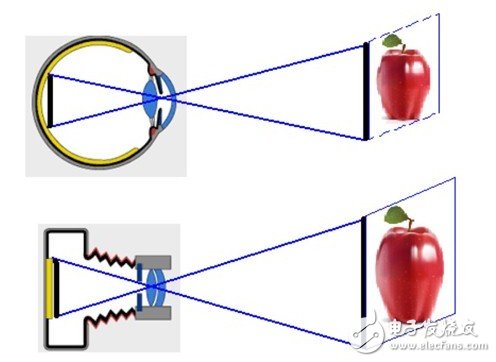Machine vision is a new technology developed in recent years. It uses optical and electromechanical integration to make machines have visual functions. Introducing machine vision into the field of inspection, online precision high-speed measurement can be achieved in many occasions. At the same time, the theory of machine vision inspection technology has also grown step by step.
What is machine vision?
Machine vision, in simple terms, uses machines instead of human eyes to make measurements and judgments. It mainly uses computers to simulate human visual functions, extracts information from images of objective things, processes them and understands them, and finally uses them for actual detection, measurement and control. The typical mechanism of machine vision consists of five parts: illumination, lens, camera, image capture card, and vision processor.

The technology derived from this is machine vision technology, which is an interdisciplinary subject involving many fields such as artificial intelligence, neurobiology, psychophysics, computer science, image processing, and pattern recognition. The biggest feature of machine vision technology is its speed, large amount of information and many functions.
Development of machine vision
The study of machine vision began in the mid-1960s with the study of the building blocks world by American scholar LR Roberts on the understanding of polyhedra. Techniques such as preprocessing, edge detection, contour composition, object modeling, and matching used at the time were later applied in machine vision. In the 1970s, machine vision formed several important research branches: 1 image processing of target guidance; 2 parallel algorithm of image processing and analysis; 3 extraction of 3D information from 2D images; 4 sequence image analysis and motion parameter evaluation; 5 visual knowledge Representation; 6 knowledge base of visual systems, etc.
What are the difficulties in machine vision technology design?
First: the stability of lighting
Industrial vision applications are generally divided into four categories: positioning, measurement, detection, and identification. Measurements require the highest stability of illumination, because light changes as long as 10-20%, and the measurement results may deviate by 1-2 pixels. This is not a software problem. This is a change in illumination, which causes the edge position of the image to change. Even if the software is not solved, the problem must be solved. From the perspective of system design, the interference of ambient light must be eliminated, and the active illumination source must be guaranteed. Luminescence stability. Of course, the improvement of resolution by hardware camera is also a way to improve accuracy and resist environmental interference. For example, the previous camera's corresponding object space size is 1 pixel 10um, and by increasing the resolution to become 1 pixel 5um, the accuracy is approximately doubled, and the interference to the environment is naturally enhanced.
Second: the inconsistency of the workpiece position
Generally, the measurement project, whether it is offline detection or online detection, as long as it is a fully automated testing equipment, the first step is to find the target to be tested. Every time the object to be tested appears in the field of view, it is necessary to know exactly where the object to be tested is. Even if you use some mechanical fixtures, you cannot ensure that the object to be tested appears in the same position every time. This requires the positioning function. If the positioning is not accurate, the position where the measuring tool appears may be inaccurate, and the measurement result may sometimes have a large deviation.
Third: calibration
Generally, the following calibrations are required for high-precision measurement, an optical distortion calibration (if you are not using a software lens, generally must be calibrated), the calibration of the second projection distortion, that is, the image distortion correction represented by the installation position error The calibration of the three object image space, that is, the size of the corresponding object space of each pixel is specifically calculated.
However, the current calibration algorithms are based on plane calibration. If the physics to be measured is not planar, the calibration will need to be processed by some special algorithms. The usual calibration algorithm can't be solved.
In addition, some calibrations, because it is inconvenient to use the calibration plate, must also design a special calibration method, so the calibration may not be completely solved by the calibration algorithm already in the software.
Fourth: the speed of movement of the object
If the object being measured is not stationary, but is in motion, then the motion blur must be considered for image accuracy (fuzzy pixels = object motion speed * camera exposure time), which is not software solver.
Fifth: the measurement accuracy of the software
In the measurement application, the accuracy of the software can only be considered in 1/2-1/4 pixels, preferably in 1/2, but not as 1/10-1/30 pixel accuracy as the positioning application, because in measurement applications. The software is able to extract very few feature points from the image.
Development and application in China
According to expert analysis, the early development of machine vision was mainly concentrated in Europe, America and Japan. With the global manufacturing center shifting to China, the Chinese machine vision market is becoming an important target market for international machine vision manufacturers after North America, Europe and Japan. In China, machine vision applications originated in the introduction of technology in the 1980s. The semiconductor and electronics industries are one of the earliest industries for machine vision applications, most of which focus on PCB printed circuit assembly, component manufacturing, semiconductor and integrated circuit devices. Etc., the application of machine vision in the industry has played an important role in improving the quality and production efficiency of electronic products.
120W quantum board adopt full spectrum light source to meet all the plant's demand on light, the heavy aluminum board can make sure heat dissipation quickly.
Grow Light Quantum 120W, grow light quantum, quantum board
Shenzhen Zhenyang Century Technology Ltd. , https://www.growlightzy.com